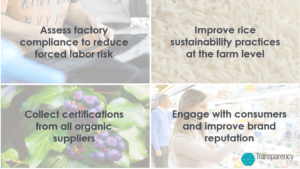 Blockchain is often positioned as a magic solution for supply chain transparency. In recent years, plenty of articles and reports have been published on the promise of blockchain for creating more transparent and secure supply chains. Between 2015 and today, Google search results for “blockchain supply chain” have increased tenfold. It is clear we are at the beginning of a new era of blockchain-driven supply chains.
Blockchain is often positioned as a magic solution for supply chain transparency. In recent years, plenty of articles and reports have been published on the promise of blockchain for creating more transparent and secure supply chains. Between 2015 and today, Google search results for “blockchain supply chain” have increased tenfold. It is clear we are at the beginning of a new era of blockchain-driven supply chains.
As with any major trend, it is important to carefully evaluate whether it is truly right for you and your business. In response to consumer and market demands, today’s businesses need to know where their products are coming from and who they are working with. But rather than assuming blockchain will answer these questions, businesses should work in reverse: first, find an effective solution to achieve supply chain transparency, then see how blockchain can be implemented for greater value.
The appeal of blockchain
Blockchain is a database that records digital transactions in secure and transparent way. Blockchains have three major characteristics that make it especially appealing for supply chain transparency:
- Blockchains can be public. Everyone participating in the blockchain can view the transactions, which are stored in “blocks.” (However, private blockchains also exist)
- Blockchains are decentralized. No single party owns the blockchain. All participants first must reach a consensus (via an algorithm) before any transaction can be added to the chain. This means greater trust of the data stored in the blockchain.
- Blockchain is secure. Data in the blocks cannot be altered, and blocks can only be added to the chain, never removed—making a blockchain database highly secure.
Public, decentralized, and secure: it’s no wonder that blockchain seems perfectly positioned to address today’s supply chain challenges.
Transparency before blockchain
So what challenges are modern-day businesses encountering? In our experience, brands, retailers, manufacturers, and suppliers are all seeking to gain more supply chain visibility to achieve a variety of objectives, such as:
- Comply with regulations on social responsibility, sustainability, etc.
- Build consumer trust in an era of increased transparency
- Increase supply chain resilience and reduce costs
- Ensure responsible sourcing and achieve CSR initiatives
These goals cannot be automatically achieved with blockchain. Rather, businesses should first focus on gaining greater supply chain transparency—in other words, determining the who, what, where, and how behind their products—before considering blockchain technology. Achieving transparency requires three steps:
- Identify: Determine and connect with supply chain partners
- Discover: Collect supply chain data, down to desired supplier tier
- Validate: Verify data for accuracy
Following these steps will provide businesses with the increased visibility necessary to achieve their supply chain goals. From ensuring more socially responsible supply chains to collecting necessary documentation for better regulatory compliance, transparency—not blockchain—is key.
Blockchain considerations
Only once the business challenges have been addressed is it time to consider blockchain. Due to its public, decentralized, and secure nature, blockchain provides a higher level of data security and immutability. With blockchain, businesses and consumers can rest assured that the supply chain data has not been falsified, modified, or tampered with.
However, blockchain is not “one size fits all.” Businesses should assess whether blockchain will truly bring value to their business. A few factors to consider include:
- Supply chain volatility: How stable is your supply chain in question? If your suppliers are constantly changing, visibility will be more challenging to achieve, and blockchain more challenging to implement.
- Product type: What products are you tracking? Different products have different requirements. For some, collecting certifications may be sufficient; for others, the additional security offered by blockchain may be valuable.
- Required data: What data are you collecting? Particularly sensitive supply chain data may benefit from blockchain’s immutability.
By taking the time to consider if and when blockchain makes sense, businesses can leverage this innovative technology more wisely and effectively.
Blockchain is a business decision, not a technology decision
Blockchain has great potential for revolutionizing the way businesses manage their supply chains. The decision to adopt blockchain technology—when to do so, for which products, or if at all—is ultimately up to each business. But it is important to keep in mind blockchain should not be implemented for the sake of the technology itself. Rather, the decision should always be based on the business: how will this technology provide greater value?
Transparency-One has partnered with Microsoft to support blockchain Ethereum capabilities for enhanced data protection. Our philosophy is simple: transparency first, blockchain second. With Transparency-One, businesses can discover, map, and digitize their end-to-end supply chains. Once supply chain visibility has been achieved, businesses can then opt to store their data in the blockchain for immutability and an additional layer of data protection.










